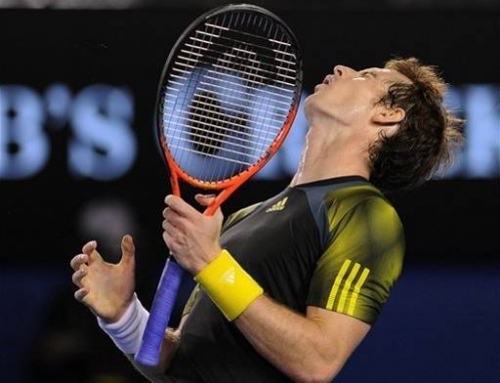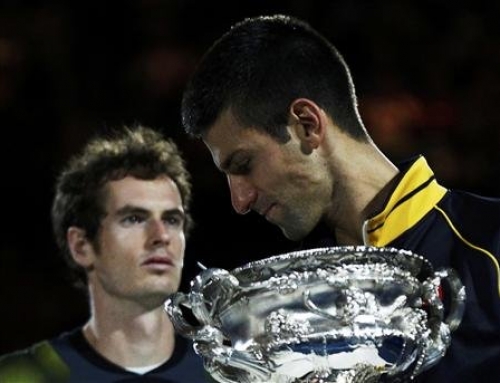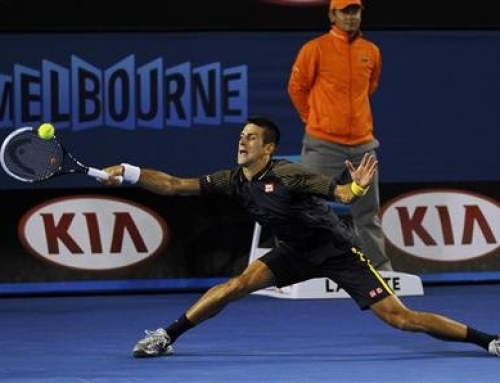 Lleyton Hewitt is a bit old school. He said he modeled his game not after the great Aussies which were in a dry spell in the late 1970s and early 1980s, but after Mats Wilander. One of his famous moves, where he bends his wrists and stares at the tips of his fingers is a Mats Wilander move he imitated. Hewitt’s game was an improvement over Wilander or Chang. He moved pretty well and always hit the ball plenty deep. He had a ferocious intensity and will to win.
Lleyton Hewitt is a bit old school. He said he modeled his game not after the great Aussies which were in a dry spell in the late 1970s and early 1980s, but after Mats Wilander. One of his famous moves, where he bends his wrists and stares at the tips of his fingers is a Mats Wilander move he imitated. Hewitt’s game was an improvement over Wilander or Chang. He moved pretty well and always hit the ball plenty deep. He had a ferocious intensity and will to win.
This style was more than enough to confound young Roger Federer and even handily win over Pete Sampras in the 2001 US Open, which,, interestingly enough, concluded on September 9, 2011 (and Hewitt hung around until September 10, before heading out to Australia). The early 2000 was an era where Sampras was getting a bit past his prime. He would continue to go deep in Slams (he reached the US Open finals in 2000, 2001, and 2002 winning in 2002), but generally didn’t care about other ATP events since his body wasn’t rugged enough to deal with the daily pounding.
At the time, he, Marat Safin, Roger Federer, David Nalbandian, Juan Carlos Ferrero, and Andy Roddick must have thought they were the inheritors to the tennis great mantle. Little did they know several things would happen.
First was the complete reinvention of Roger Federer. Roger Federer only met Pete Sampras once in official tournament play. They met in the fourth round of Wimbledon in 2001. Federer came out victorious that day playing a style that was still viable in those days: serve and volley. Federer struggled against the new breed of baseliners, Lleyton Hewitt and David Nalbandian, who were fast, hit deep, and just a bit harder than their predecessors. They didn’t whip winners a la Agassi which is one reason Agassi continued to be productive until the mid 2000s.
Roger Federer worked hard on his ground game. He wanted to be just as steady and quick as his opponents, but he wanted a weapon. He wanted to be able to close out points. Hewitt and Nalbandian relied as much on opponent error as anything. They weren’t trying to beat you by hitting winners, at least, not usually. Federer developed patterns of play that allowed him to take first strike on inside out and inside in forehands, and made the game of tennis resemble ping pong on steroids.
Then, came the new players. First Rafael Nadal around 2005, then Djokovic in 2007, and Murray in 2008 (though he was plenty visible by 2006), and del Potro also in 2008. This middle 2000 era brought a bunch of players that could work the angles of the court. When Nadal burst on the scene, he put such wicked spin on the ball, and dropped angles that had not been seen before that players struggled to deal with his game. Only a certain temerity about attacking kept Nadal’s arsenal under wraps and made him somewhat playable. But these power players hit that much harder and created that much more angle.
Meanwhile, players like Nalbandian and Hewitt, still pretty successful by around 2004, were finding it tougher and tougher to play these players. Only Andy Roddick with his huge serve kept his ranking high in the top ten. And Nalbandian and Hewitt both suffered injuries. Though both remained resolute in coming back, it was very difficult for them to compete only 5 years after they were at the top of the game.
And so that was the scenario Hewitt found himself. He had already beat a nemesis in Andy Roddick mostly because Roddick hurt himself, and then beat up-and-coming Milos Raonic, mostly because he managed to return the serve somewhat well, and because Raonic still lacks the steadiness off the ground that he needs to handle Hewitt.
But against Novak Djokovic? Oh sure, Djokovic was vulnerable after the US Open. Despite weeks of recovery, he didn’t seem to be at his best and there was some worry that maybe Novak’s worries were not behind him. He only opted to play the Abu Dhabi event. It was encourarging when he demolished Federer and Ferrer, but it was an exhibition, after all. Even after claims that he was fine, ready to defend his title, it wasn’t a sure thing until the tournament started and he quickly took care of his first three opponents, barely dropping games. Admittedly, they weren’t exactly great opponents so Hewitt might show the form Djokovic was in despite Hewitt having been injured in 2011, and still not 100%.
In the first two sets, especially the first set, Djokovic showed his imperious form. Playing Djokovic is like playing the classic video game, Breakout. It’s a wall that keeps getting the ball back. Hewitt lacks the power that other players have. Even David Ferrer, a decided counterpuncher, is more aggressive than Hewitt and is just as quick and steady. The little Spanish terminator hits a tougher ball than Hewitt. Hewitt’s main strength is his fight and his deep shots. He doesn’t even have a big enough serve to rely for free points.
Unable to withstand the barrage of Djokovic’s hard struck, precise balls, Hewitt was made to look like a bad practice as Djokovic calmly chased down balls and placed them at will. The second set was better, but as Hewitt was trying to hold serve to keep the set at one break down and reach 4-5, he got into a long protracted game where he had deuce several times, but ultimately got broken again and lost the set 6-3 instead.
The third set looked like more of the same. Djokovic got out to a 3-0 lead, and it looked over for the Aussie. Folks began to leave the court as it was already pretty late. But somehow Hewitt kept getting to shots, and Djokovic, all of a sudden, started to his shots long and into the net. Hewitt takes three games in a row before Djokovic manages to win another game. Then Hewitt held again to 4-all and broke again in a very long game and held his own serve to take the set. Djokovic has lost the first set in the tournament.
Now everyone knows if Djokovic had been playing the game he had in the first two sets, it would have been over, but that lapse was enough for Hewitt’s scrambling to pay off. Did Djokovic become Mr. Nice Guy so he wouldn’t humiliate Hewitt in front of his own crowd? One wonders.
The fourth set was close at the start. The two hold serve until 3-2 when Djokovic gets the break to 4-2, then holds to 5-2. The two hold serve one more time, and Djokovic has won the match.
Djokovic will face the David Ferrer in the quarterfinals. Gasquet had an impressive run through the first three rounds. The Frenchman was perhaps more famous than Venus Williams who found herself in tennis magazines at the age of 12. This wasn’t far from the experience that Gasquet had. He was the next French saviour. He once said that he played tennis the French way. With style and power. He had prodigious talent but maybe not prodigious work ethic. It didn’t help that Gasquet liked playing way behind the baseline looping his shots on both sides and making it easier for opponents to stay even with him. Gasquet’s backhand was once considered the best one-hander in the game. And while he’s capable of magic from that side, it doesn’t hold up under steady attack.
Some prognosticators thought Gasquet had a chance against Ferrer. He had demolished ninth-ranked Janko Tipsarevic. However, some also felt Tipsarevic’s appearance in the top ten is mostly smoke and mirrors, a product of nice steady play and two tournament wins, but not from big victories over the biggest players. In any case, Tipsarevic is no David Ferrer. Ferrer is a bulldog of a player. He has just enough game to keep things modestly interesting when he plays the top four, but alas not enough game to beat them unless they are a bit off their game, which he did against Murray and Djokovic in the year-end championship last year.
Ferrer has a 5-1 record over Gasquet and all of the wins weren’t close. They were of the 6-3, 6-3 variety. But surely the swashbuckling Gaul could muster a challenge to the Spaniard? Yes? No.
Ferrer won handily, 64 64 61. Gasquet tried to get into backhand-to-backhand exchanges, but Ferrer was steadier on his weaker wing. Gasquet didn’t have enough magic to push Ferrer away from his usual game, and perhaps lacked the stamina too. By the third set, with the end far in sight, Gasquet realized it was too much to keep staying even with Ferrer, or more properly, just a little behind, and lost that set handily.
Now the quarterfinals are set for the top-half of the draw. Murray will play Nishikori. Given Nishikori’s lengthy matches in the past three rounds, he’ll be struggling with recovering enough to play Murray. Murray meanwhile had a rest against Kukushkin who found himself in the same boat as Nishikori–having played a pair of five setter to reach this point. The other quarterfinals pits Novak Djokovic against David Ferrer in the first real test of Djokovic’s return. Ferrer beat Djokovic the last time the two met, namely, back in London. To be fair, Djokovic wasn’t exactly 100% back then. And, oh yes, they did meet in Abu Dhabi, and Djokovic easily beat Ferrer there.
Djokovic is favored to win. Ferrer will have to hope for mental lapse if he expects to win, but at least he’s had some victories over the Serb.
Tonight, Federer takes on del Potro, and Nadal takes on Berdych. Federer and Nadal are expected to win. Federer probably has the tougher deal. del Potro is starting to regain some of his form. He may not be nearly as imposing as he was three years ago, but he is very steady. In 2011, del Potro worked on his first serve first, then getting himself steady off the ground, then adding more power off the ground. For a big man, he’s a lot steadier from the back than Querrey or Harrison of anyone of his height, save perhaps an in-form Cilic. And he’s always had his huge forehand.
Federer is likely to push del Potro to run as much as possible. del Potro hides his height pretty well mostly because people are afraid to hit to his forehand. del Potro is also not quite ready to beat top players, but he has to start at some point. The big question is whether it’s now or not.
Nadal is favored against Berdych. If nothing else, he’ll have fan support. Aussies really believe in sportsmanship, perhaps more than any other country, and the mercilessly booed when Berdych refused to shake Nicolas Almagro’s hand. Almagro isn’t exactly a likable guy either, but it didn’t matter for most who only saw a 3 minute clip and made up their minds. Not that Nadal particularly needs it. Berdych beat Nadal around 5 years ago just as Nadal was getting good, and beat him on hard courts. Since then, Nadal has taken the last 9 matches, on all surfaces, hard, grass, and clay.
If Berdych has a weakness, it’s his movement. He’s a big guy. He moves reasonably well mostly because he hides his deficiency behind his power. By hitting so hard, he takes advantage of when he’s in a bad situation. Berdych has pretty good speed if he heads in one direction, but struggles if he has to switch directions. Nadal is going to use his high looper to counter Berdych’s power shots and force him to hit another shot and hopefully elicit an error, and use his angles to move Berdych around. His goal is to make Berdych hit one more shot than he wants to.
Berdych, meanwhile, will want to serve big and attack Nadal’s second serve like he did Almagro’s second serve. In a way, Almagro played a bit dumb by aiing to Berdych’s superior forehand so often instead of playing the backhand. Berdych takes risks. The hard courts, however, is his best surface, so if Berdych is likely to pull the upset, he needs a slightly out-of-form Nadal, plus he needs to hit his serves well (which he’s capable of) and he needs to attack the Nadal second serve. All of this is within his capabilities. The question is whether all that is enough. He’ll still have to play out of his mind. The only positive aspect is that he’s playing pretty good right now. But then he was playing pretty good at the 2010 Wimbledon final and still didn’t make an impression in Nadal’s game.
So it looks very much like a Federer-Nadal semifinal.






![[Aussie Open Final] Can Andy Murray beat Novak Djokovic?](https://www.essentialtennis.com/wp-content/uploads/2013/01/20130126andy-500x383.jpg)
![[Day 13, Aussie Open] Bryan brothers win 13th Slam with Aussie doubles title, Kyrgios wins boys title](https://www.essentialtennis.com/wp-content/uploads/2013/01/20130125bryan-500x383.jpg)